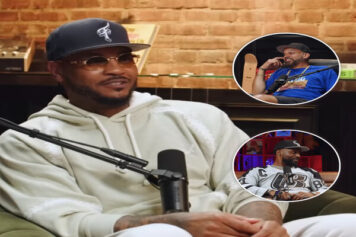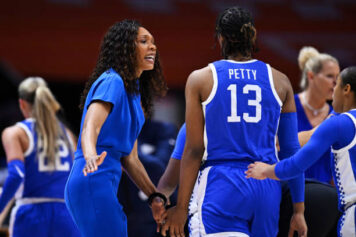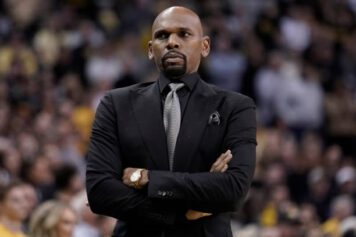For three years, the specter of Kemba Walker hovered over Shabazz Napier with his disembodied voice being projected through media scribes. I joked throughout the tournament that it reminded me of fictional Washington Huskies Antoine and Kenny Tyler in 1997’s The 6th Man. Rollie Massimino’s ’87 Villanova Wildcats are the only team seeded as high as UConn to hoist championship hardware.
The voices comparing Walker and his protégé hushed during Napier’s junior season when UConn was banned from postseason tournament participation and Napier made his most visible improvements as a point guard. That suspension included exclusion from the final Big East tournament funeral and the NCAA Tournament.
It should be clarified that UConn’s postseason suspension was related to a report card that averaged scores from 2007-08 through the 2010-11 academic years.
On his chariot ride away from the NCAA's grasps, Napier flew near the boiling center of the collegiate athletics universe and lobbed a pointed message in the NCAA’s direction.
"I want to get everybody's attention right quick. If I don't have your attention, let me get your attention. Ladies and gentlemen, you're looking at the Hungry Huskies. This is what happens when you ban us … last year … two years.” Napier proclaimed with a disdain that he could only have inherited from Jim Calhoun “We worked so hard for it. Two years and hungry. Hungry Huskies."
Hungry Huskies was another surreptitious dig at the NCAA, relating to Napier’s disclosure earlier in the day about going to bed starving some nights and the inherent emotions about exploitation that it brewed inside of his barren stomach.
As Napier's senior season progressed and he began compiling accolades, the Kemba whispers rose to a roar. Once UConn reached Madison Square Garden for the Sweet 16, and nearly took corporeal form when he hoisted the East Regional Championship trophy. The weight of the pressure never appeared to weigh him down. Instead, Napier floated weightlessly as split the defense, ventured into the paint and fluttered to the rim.
Napier had it easy compared to the disembodied Harvard accent booming from within UConn’s athletic quarters reminding Kevin Ollie of the even loftier legacy he would have to chase. Calhoun’s skyscraping shadow makes Walker’s look like a drink umbrella because unlike Walker, Calhoun is still an athletic department adviser with a nearby office. What could have been an unmitigated disaster has blossomed into an unlikely success story. It’s not a knock on Ollie, but rather of the circumstances he’s overcome in the last 19 months.
Ollie disagreed with the notion of UConn being a Cinderella in his post-title press conference, but Ollie himself is the Cinderella coach. Michigan’s Steve Fisher, who won his only title after assuming the coaches vacancy following the ouster of Arizona State-bound head coach Bll Frieder before the NCAA Tournament is the only head coach to win a national title in his first tournament.
UConn had won three national championships since Calhoun transmogrified a .500 Big East program and aspiring regional powerhouse situated in the heart of ESPN territory into the Northeast’s preeminent hoops campus.
When Calhoun retired after a serious bicycle accident one month before the 2012 season began amid a myriad of NCAA investigations and minor violations which piled up like C-notes in a Miami night club floor, in addition to the dissolution of the Big East, Ollie was perceived to be the priest of UConn basketball, overseeing the last rites of a national powerhouse expelled from the exclusive power conference club.
Not only was Ollie a relic of the early Calhoun come-up era, but he didn’t have much buzz behind him in the coaching community. He was expected to serve as a bridge to UConn’s next full-time head coach after being awarded a one-and-done sacrificial lamb contract while the administration scoured the landscape for a high-profile name. Arizona’s Kevin O’Neill was the model for UConn’s succession plan. Five years earlier, Arizona temporarily promoted O’Neill from staff assistant to Lute Olsen’s post while he recovered from a bout with depression. Later in the 2007-08 season, O’Neill was later named the coach-in-waiting for Olsen, who expected to eventually return to the bench, but would never coach another game. O’Neill’s inaugural season was analogous to the Red Wedding. After Olsen briefly returned the next season, O’Neill was axed like Ned Stark and assistant Russ Pennell was soon named the interim head coach following Olsen’s retirement in October of 2008.
Pennell led the Wildcats to a Sweet 16, but the call to remove his interim tag was drowned out when Arizona opted for a young, rising coaching general from Xavier named Sean Miller.
A 20-10 campaign in Ollie’s inaugural campaign last year as the Huskies’ “interim” head coach” was obscured by APR penalties didn’t alleviate the legitimate concerns that UConn would retreat into the shadows of an entity that resembled their old digs in the old Yankee Conference.
After the Big Ten opted for Rutgers’ potential stranglehold of the New York City market, UConn began this season in limbo as an supporting character in the Louisville conference aka the American Athletic Conference as part of the Big East divorce settlement. In retrospect, the tournament’s biggest error of the tournament was undervaluing the AAC.
Cincinnati pulled itself up by the bootstraps for a second place finish in the American Athletic Conference, but its offensive limitations placed a ceiling on their season. It was shouted from every single barn rooftop that Louisville was underseeded as a 4, however, SMU stumbled one possession away from doubling down the NIT title for the conference’s coffers as well.
Instead of taking its last, desperate gasps, UConn delivered a defiant message to the nation. They returned to the site of the Big East Tournament and upended the bracket darling Michigan State Spartans. Then, they snuffed out the nation’s No. 1 team for the second time this season, proving December’s win wasn’t a fluke, before laying waste to the most highly-touted freshman phenoms in over 20 years.
To do so, Ollie had to become a hybrid of Coach Carter and Principal “Crazy Joe” Clark of UConn basketball. Like, the energetic principal who returned to revitalize Eastside High School. Ollie managed UConn back on track academically and athletically.
"If they oversleep, you wake 'em up and tell 'em to go to class," Junior guard Ryan Boatright explained in detail about Ollie’s stringent course attendance policy back in early October. "Because if you oversleep and miss class and they check your class, we've got to run for that. Nobody wants to run for somebody else not going to class, so we definitely make sure everybody goes to class and does their work."
Napier and Boatright were the ideal guards for Kevin Ollie to mentor. Ollie’s journeyman career included a plethora of stops, but none was more memorable than his tenure in Philadelphia. It was the first time I heard of Ollie back when he was a key contributor on the scrappy Sixers squad that scratched and clawed their way to within three wins of an NBA title.
Allen Iverson was the heart of the team and Eric Snow excelled as Iverson’s right hand man, but Ollie was the court brain off the bench as an extension of Larry Brown. It was fitting that UConn prepped for this week’s Final Four in SMU’s facility. Ollie was the type of NBA player-team manager who was seemingly kept around for his clean locker upkeep, court etiquette and tenacious “practice” habits. He was the anti-Iverson and a well-adjusted human Tylenol for the headache that frustrated artist The Answer could be.
Ollie’s even-keeled demeanor was evident on the floor when he led the league in assist-to-turnover ratio the previous season in Milwaukee and Seattle, after being used as a trade chip in the Ray Allen-Gary Payton swap. In 2003, Cleveland Cavaliers general manager John Paxson gave Ollie a three-year $15 million deal to play point guard and mentor an 18-year-old rookie.
"I just think his professionalism and approach to the game is what players followed," John Paxson said. "Even though LeBron was a great player when he first came in the league, along the way, in my first couple of years around him and even after that, (LeBron) was always looking for veterans in the league that did it the right way. Kevin had a good approach with LeBron and other young players – being a professional, showing it on a day-to-day basis that you've got to show up, work on your game, work on your body."
Last week, Kevin Durant told Grantland that Ollie infused a professional culture into the Thunder locker room and “taught him the ropes.”
Napier and Jeremy Lamb were essential freshman contributors sired from Calhoun’s Class of 2010. Lamb purchased his NBA lottery ticket after a standout sophomore season alongside Andre Drummond and was drafted by Ollie’s final NBA employer, the Oklahoma City Thunder in 2012.
Their exodus occurred right when the program began to implode, Napier stuck around when the program was stuck in the doldrums and the NCAA allowed players a window to transfer and play without the mandatory redshirt year.
“My sophomore year I didn’t play the way I was supposed to,” Napier said last week. “I wasn’t a great leader, and I felt like I owed a lot to the university. I felt like they stayed loyal to me and I wanted to stay loyal back.”
Then-sophomore Boatright replaced Lamb as his right hand man. Fellow Class of 2010 prospect Roscoe Smith transferred to UNLV after his sophomore year, where he averaged a double-double this season before declaring for the draft.
In the modern NCAA Tournament beginning with 1979’s Magic-Bird clash, only four players have accumulated 125 points, 25 assists and 25 rebounds in one tournament; Kemba Walker, Derrick Rose, Larry Bird in ‘79 and now Shabazz Napier.
As UConn’s head coach, Ollie became the Shabazz whisperer tasked with taming Napier’s overconfident personality and honing his ball-dominating tendencies. Napier and Iverson share a similar gift for contorting their bodies for baskets in the paint and would fearlessly sprint the wrong way during Pamplona, Spain's Running of the Bulls if they thought there was the possibility of generating a lane to the hoop. On Monday night, Napier still displayed a tendency to run cone drills through the defense and get too cute with his dribble, but he also was peering at the game through a more advanced lens than anyone else on the floor.
Defensively, Boatright and Napier’s pressure kept the Kentucky offense out of its operating zone as the Harrison twins were often initiating the offense nearer to half court than the three-point arc. The group of seniors who played on both the 2011 and 2014 squads including Napier, Tyler Olander and Niels Giffey may be the winningest group of seniors to matriculate through college hoops in this age of one-and-dones.
Waiting for this photo of Ollie & Napier to end up on Instagram w/ #ThisCouldBeUsButYouPlayinOneNDone hashtag pic.twitter.com/jyB3qvdJyf
— DJ RedHerring Dunson (@CerebralSportex) April 8, 2014
Their experience and resilience was on display Monday night after James Young, one of the nation’s most prolific three-point shooters, cut the ambilical cord with the three-point arc. Young drove the lane, gathered himself mid-air and posed for a viral Ellen Oscars above the rum dunk selfie with two UConn rim protectors that sparked an 8-0 run which pulled Kentucky to within one.
Napier, who’s so coldblooded he could Draino a trey on the balcony of the sinking Titanic, dribbled down the floor, quickened his dribble and squared up for a fadeaway three. On their next possession, Napier dished to a struggling Niels Giffey, who drilled another three from the same spot on the next time down the floor.
However, it’s up to the next wave of wide-eyed recruits to carry on the Huskies legacy in the long-term. John Calipari isn’t the most X and O savvy coaching intellect stalking a sideline, but his branding and cult of personality have allowed him to rise to the throne of college basketball’s purest blue chip program during an era that suits his philosophy best.
Rumors of Calipari’s Lakers dalliance will circulate around the Kentucky program more vociferously than those pesky Saban to Texas rumors for the next few months.
The NBA will tap on Ollie’s door and harass his agent for the next few months, but he’d be prudent to throw on his Beats by Dre and tune out the noise. The next challenge success with All-American transfer Rodney Purvis and Sam Cassell Jr. and Boatright is sustaining success and proving he’s more John Thompson or Nolan Richardson than Tubby Smith, who was dismissed for winning with Pitino’s players or Steve Fisher.
Eerily enough, Larry Brown was also the only coach to leave for the NBA immediately after winning national championship. Ollie can either hopscotch from city to city to risk becoming an NBA nomad like Brown or he could take Fisher’s route building a hoops home at his alma mater. Whether or not the seventh-seeded Huskies qualify as a Cinderella is up for interpretation, but their fourth championship vaults them into the upper echelon of blue chip programs and Ollie is the head brotha in charge.



